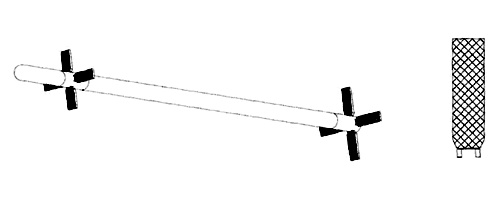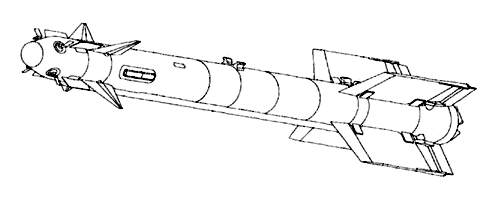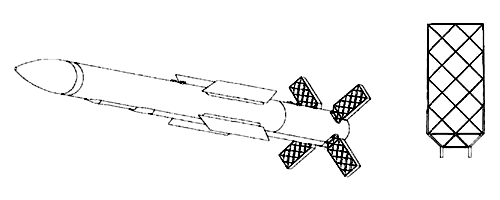- Joined
- 27 December 2005
- Messages
- 17,748
- Reaction score
- 26,421
VATOLIN Valentin Vladimirovich - Chief Researcher of JSC "GosMKB" Vympel "named after I.I. Toropova ", professor, doctor of technical sciences.
BARANOV Igor Vladimirovich - Chief Specialist of OJSC "GosMKB" Vympel "named after I.I. Toropopa, Ph.D. of sciences
SUDARKIN, Yuri Stanislavovich - Chief Specialist of JSC "GosMKB" Vympel "named after I.I. Toropova »
Specialists of many countries, including the USA, France, India, and China, have aroused considerable interest at international aerospace salons in the medium-range air-to-air missile with lattice rudders under the RVV-AE index.
Lattice wings (polyplanes) began to be used in aviation more than 150 years ago. The glider-triplane of the design of the English scientist J. Cayley made a non-motorized flight in 1849. Interest in lattice structures grew both in a number of Western countries and in Russia, where N.E. Zhukovsky and S.A. Chaplygin paid great attention to the problem of lattice wings. . However, later, as flight speeds increased, world aviation science and technology focused on the study and application of monoplane wings. Interest in polyplanes, with the exception of biplanes, has fallen.
In the early 1950s lattice structures again attracted attention. The development of rocket technology required the search for new aerodynamic systems that have the best bearing properties with small dimensions and weight.
Scientific research in the field of lattice wings has led to the understanding that the main feature of such a wing as a supporting structure, fundamentally distinguishing it from traditional monoplanes, is the rational spatial distribution of wing force elements, in which the plane of greatest structural rigidity coincides with the plane of action of the greatest aerodynamic loads. This huge advantage could not but lead to a significant gain in weight return for a given lifting force.
The typical design of the lattice wing for missiles consists of thin-walled intersecting plans, a power frame and an arm for attaching the wing to the rocket. The ends of the plans and the frames on the inlet and outlet side of the air flow are pointed. Lattice wings have a number of advantages over conventional monoplane wings. Among them:
- a large total area and, as a result, an increase of up to three times the lift;
- the possibility of folding along the rocket hull, which allows to increase the ammunition load and reduce the aerodynamic drag of the carrier aircraft or spacecraft at the starting section of the trajectory;
- small articulated moment, leading to a decrease in power and mass of the rocket control power unit, which allows to increase the flight range or increase the mass of the warhead;
- the possibility of increasing the efficiency of controls by increasing the number of cells of the lattice surface within the specified overall dimensions;
- continuous flow of planes of lattice surfaces to angles of attack of ~ 40 °, which is especially important to ensure increased maneuverability of the developed missiles.
At that time, the United States was armed with good missiles: a melee Sidewinder and a medium-range AMRAAM.
By the decision of the government of our country, initially all efforts were aimed at creating a short-range air combat missile that surpasses the American missile in its characteristics. The solution to this problem in 1968 was entrusted to a design bureau headed by chief designer A. V. Potopalov. In KB, this work was led by Lead Designer L. I. Ryndin (1928 ... 1995), a talented engineer with a wide range of advanced ideas. Under his leadership, together with VVIA them. prof. N.E. Zhukovsky developed the concept of a small-sized rocket, which was called "Bisector", with new technical solutions: lattice wings, bisector control circuit, paste-type engine, electric drive.

Missile Bisector
After the closure of A. V. Potopalov’s design bureau, all the work was transferred to Vympel Design Bureau, where L. I. Ryndin also went to work. In Vympel Design Bureau, a team was organized consisting of specialists of various profiles, led by the lead designer L. I. Ryndin. According to the plan of the performers and development managers, the missile was to surpass both foreign and domestic counterparts in its tactical and technical characteristics due to the use of the latest achievements of science and technology in each of its elements. Thanks to the creative cooperation of the Vympel Design Bureau specialists with the creators of new equipment in specialized design bureaus, scientific and educational institutes, industrial enterprises, military engineering academies and schools, these missile components were developed precisely:
- homing thermal head (TGS), providing a four-fold increase in the coordinator's tracking speed (used later in the R-73 rocket);
- laser non-contact target sensor;
- thermo-accumulator electric battery;
- a paste-fuel engine with the placement of combustion initiators inside the fuel and with guaranteed fuel stability to overloads;
- warhead;
- autopilot;
- trellised wings and launch tubes for suspension of missiles under the carrier aircraft.
During the period of R&D, design documentation for various types of missiles was developed, their prototypes were made for laboratory and bench tests, and 31 missiles were launched from the ground and carrier.
The main characteristics of the bisector rocket
Starting weight | kg | 18 |
Case Diameter | mm | 76 |
Length | mm | 2100 |
Warhead mass | | 2,4 |
Side overload | | 32 |
Starting pipe diameter | mm | 120 |
Extremely laborious work when creating the rocket "Bisector" There was a development of lattice rudder manufacturing technology. In the process of testing the optimal design and technology of trellised wings, more than 120 types of model and full-scale samples were manufactured. The stability of the performance of each operation associated with the manufacture of the frame and wing plans was ensured by the mechanization of all technological processes, which guaranteed the assembly of plans and frames based on their complete interchangeability.
Lattice wings with high strength and stiffness required for a rocket, with minimal drag, were not previously created. A serious preliminary theoretical and experimental study of a number of technological and material science problems was required. It was necessary to choose the most high-strength steels, to study the processes of manufacturing structural elements and means of their assembly, to find the brand of solder, the method of supplying it to the joints and the optimal soldering mode and method of heat treatment of the product. Due to the large number of cells in the wing, it was necessary to study the effect of fillet fillets at the crosshairs and around the perimeter of the honeycomb on the strength and aerodynamic characteristics of structures.

R-73 rocket
It is noteworthy that from the very beginning of the work on the creation of the Bisector rocket, computers were widely used to select the optimal solutions, which was a characteristic feature of the activities of the head of the complex scientific direction for the study of lattice wings, Professor SM. Belotserkovsky and his associates.
Due to a number of circumstances, in 1981 the work on the Bisector rocket was discontinued.
Further work on short-range aerial combat missiles was continued at the Lightning NGO. Under the direction of the chief designer of the Molniya NPO, M. R. Bisnovat, the R-73 missile was designed with a TGS, combining the qualities of short-range and close-range missiles. This missile was adopted in 1983.
The R-73 missile strikes air targets at any time of the day with active opposition by the enemy in a range of heights from 0.02 to 20 km both from the back hemisphere and at intersecting courses. With the engine running, rocket control and stabilization through the main channels are carried out jointly by aerodynamic and gas-dynamic bodies.
To launch a rocket from a carrier aircraft, a P-72 rail launcher is used.
The main tactical and technical data of the R-73 missile
Starting weight | kg | 105 |
Length | mm | 2900 |
Case Diameter | mm | 170 |
Wingspan | mm | 510 |
Wheel Span | mm | 385 |
Warhead mass | kg | eight |
Maximum launch range in PPS | Km | thirty |
Minimum launching range in ZPS | Km | 0.3 |
Type of warhead | | Rod |
Fuse type | | Laser non-contact |
Propulsion system | | Single-mode solid propellant rocket motor |
Height of hit targets | Km | 0,02 ... 20 |
Maximum speed of hit targets | km / h | 2500 |
Overload hit targets | | Up to 12 |
Chance to hit a target F-15 | | 0.6 ... 0.8 |
This medium-range missile uses an active homing radar (GOS), which does not require target illumination by a radar station (radar) of the carrier, i.e. the principle of "let go, forget" is realized. The missile is equipped with a laser fuse that irradiates the target and gives a signal to detonate the warhead at an optimal distance from the target. The composition of the missile equipment includes miniature BTsVM, which allows you to quickly rebuild the parameters of the flight stabilization and guidance systems and respond to changing conditions of combat use.

RVV-AE rocket
The missile can hit targets at altitudes from 20 to 25,000 m, the firing range in the front hemisphere is from 300 m to 80 km, it can hit targets maneuvering with an overload of 9. It is inferior in mass to its foreign counterpart, the AMRAAM missile, and in range - superior. The cost of the RVV-AE rocket is lower than the cost of AMRAAM.
One of the important structural solutions of the RVV-AE rocket, which ensured its high tactical and technical characteristics, is the use of trellised rudders in combination with flat wings of small elongation. It was the proximity of aerodynamic surfaces that became the positive difference between the layout of the RVV-AE rocket and the layout of the Bissector rocket.
When creating the RVV-AE rocket, as well as when creating the Bisector rocket, it took a lot of labor to develop lattice rudder manufacturing technology. Due to the small dimensions of the steering wheel, the grid plans must be very thin (0.6 ... 0.8 mm) so as not to increase the drag of the rocket. Connection of plans is done by soldering.
The RVV-AE missile is mounted on a carrier aircraft, provided with the necessary power supply in their joint flight, tactical launch and emergency missile discharge are carried out using the AKU-170E aviation ejection device.
The main tactical and technical characteristics of the RVV-AE rocket
Starting weight | kg | 175 |
Length | mm | 3600 |
Diameter | mm | 200 |
Wingspan | mm | 424 |
Wheel Span | mm | 700 |
Shipping clearance | mm | 300 × 300 |
Height of hit targets | Km | 0,02 ... 25 |
Maximum speed of hit targets | m / s | 1000 |
The number M of media at launch | | 0.6 ... 2.5 |
Minimum starting range | Km | 0.3 |
Maximum fighter launch range | Km | up to 50 |
Chance to hit a target F-15 | | 0.6 ... 0.7 |
Type of guidance system | | ANN with RK + ARL |
Type of fuse | | Laser non-contact + pin |
Type of warhead | | Core, multi-cumulative |
Warhead mass | kg | 22.5 |
Propulsion system | | Single-mode solid propellant rocket motor |
The RVV-AE missile has been demonstrated at international aviation exhibitions since 1992 and is currently used in a number of foreign countries.
Last edited:
